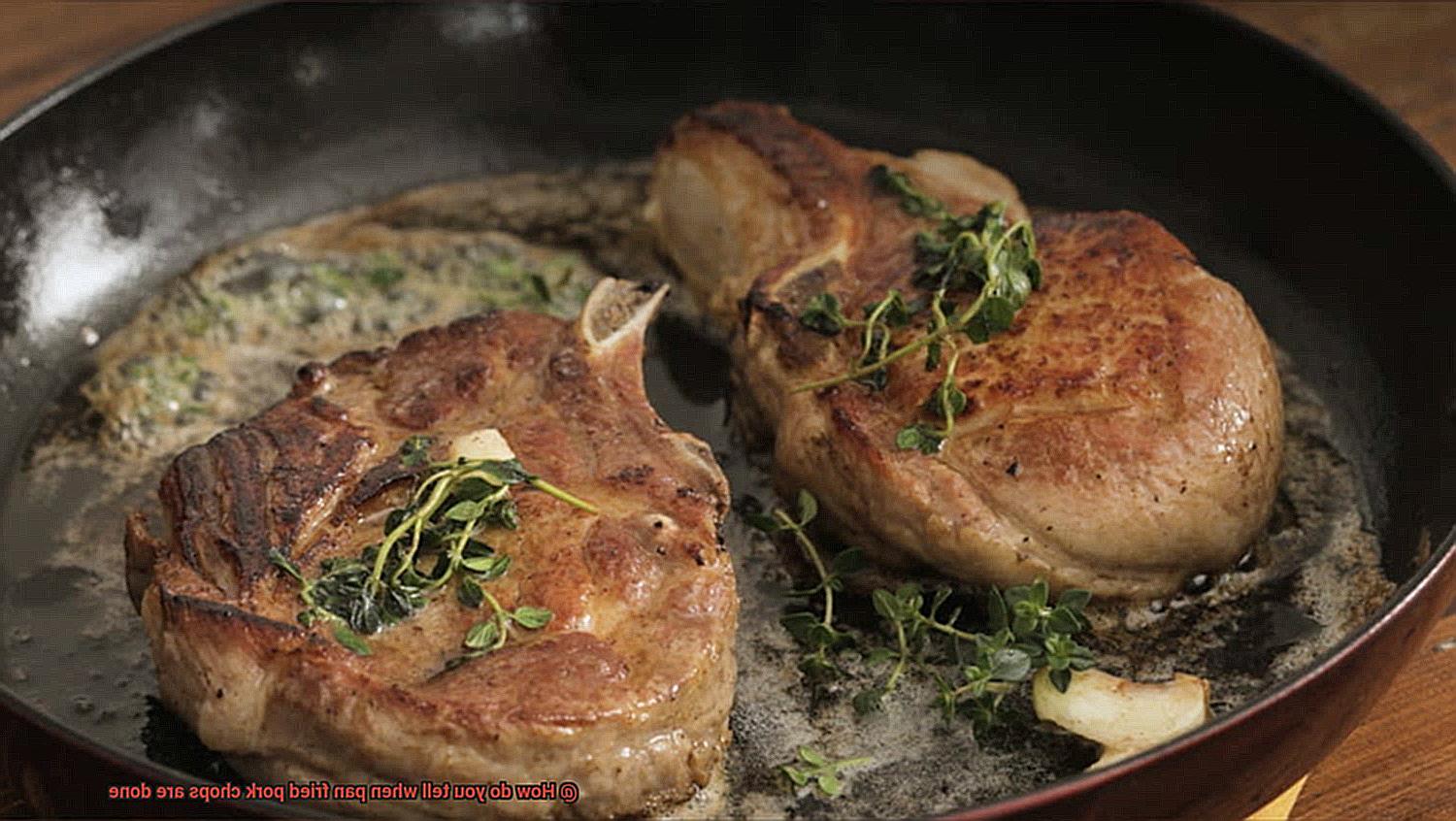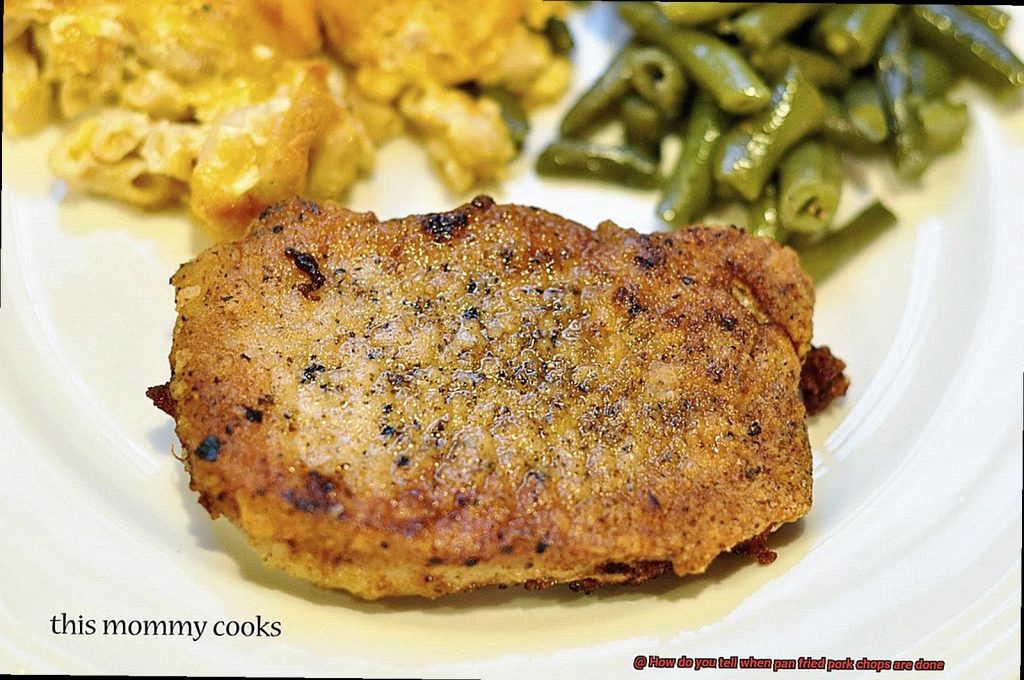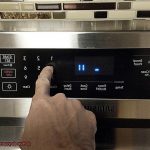Do you crave the succulent taste of pan-fried pork chops? Are you often left wondering if your pork chops are cooked to perfection? You’re not alone in this quest for the perfect chop. Cooking pork chops can be a bit tricky, but with some know-how and practice, you can master the art of cooking juicy and flavorful pork chops.
Determining when your pork chops are fully cooked doesn’t require rocket science. With a few easy-to-learn techniques, you’ll be able to cook up perfectly done pork chops every time. Checking for color, texture, and internal temperature are just a few ways to tell when your pork chops are ready to be devoured. In this blog post, we’ll delve into these methods so that you can stress less and enjoy more.
Whether you’re a beginner or an experienced cook, this guide will give you the skills and knowledge needed to create mouthwatering pork chops every time. So let’s jump right in and discover how to tell when your pan-fried pork chops are done.
Contents
What is Pan-Fried Pork Chops?
Pan-fried pork chops are a delectable dish that can be prepared in a multitude of ways, making them a versatile and popular choice for any meal. Whether you’re an experienced home cook or just starting out, pan-frying is a quick and easy cooking method that can yield deliciously crispy and juicy pork chops.
To begin with, selecting high-quality cuts of meat is crucial to ensuring the success of your dish. Opt for fresh pork chops that are free from any signs of spoilage or discoloration. Thick-cut pork chops are ideal as they will retain their moisture and flavor even when cooked at high temperatures.
The next step is to season your pork chops with your preferred blend of spices and herbs. Salt and pepper are pantry staples, but don’t be afraid to get creative with garlic powder, paprika, or rosemary for added depth of flavor. Rub the seasoning onto both sides of the pork chops evenly and set aside.
Heat a skillet or frying pan over medium-high heat with a tablespoon of oil or butter. Once the oil has heated up, add the pork chops to the pan and cook for 4-5 minutes on each side until they are golden-brown and crispy on the outside. It’s important to use a meat thermometer to check for the internal temperature of the pork chops; when it reaches 145°F, remove them from heat.

Remember not to rely solely on visual cues or touch tests to determine if your pork chops are fully cooked. Always use a meat thermometer for precise results. Let your pork chops rest for a few minutes before serving, allowing the juices to redistribute throughout the meat resulting in a succulent and flavorful dish.
Why Is It Important to Know When Pork Chops Are Done?
There’s nothing quite like the aroma of sizzling pork chops on the stove. But, do you know why it’s crucial to know when they’re done? Let me tell you, as an expert in this matter.
Firstly, undercooked pork can lead to serious foodborne illnesses like trichinosis. This parasitic infection caused by roundworms can make you incredibly sick. To avoid this, it’s crucial to cook your pork chops to a safe internal temperature.
The texture and taste of your pork chops depend on their doneness level too. Overcooked pork chops can be dry and tough, while undercooked ones can be chewy and unappetizing. You want your pork chops to be juicy, tender, and packed with flavor – right?
So, how do you achieve the perfect level of doneness? It’s all about knowing how to test for it. Some people prefer their pork chops well-done, while others like them a bit pink in the middle. Knowing how to test for doneness can help you achieve your desired level of deliciousness.
Here are some ways to test your pork chops for doneness:
- Use a meat thermometer: This is the most accurate way to determine if your pork chops are cooked through. Insert the thermometer into the thickest part of the chop; it should read 145°F (63°C) for safely cooked pork.
- Check the color: If you cut into your pork chops and see pink or red juices, they’re not yet fully cooked. The juices should run clear when done.
- Give it a press: If you press down on the center of your chop with a fork or tongs and see clear juices coming out, it’s ready.

The Most Reliable Method: Using a Meat Thermometer
As a pork chop connoisseur, nothing is more important to me than ensuring that my dish is safe to eat and cooked to perfection. And the most reliable way to achieve this is by using a meat thermometer.
Why is the meat thermometer the most reliable method, you might ask? For starters, it eliminates all guesswork from the equation. Unlike relying on visual cues or pressing down on the center of the chop, which can be unreliable, a meat thermometer tells you exactly when your pork chops are cooked all the way through. This takes out the risk of undercooking and risking foodborne illnesses or overcooking and ending up with a dry and tough chop.
But it’s not just about reliability. The method of inserting the thermometer into the thickest part of the pork chop ensures that you get an accurate reading of the internal temperature of the meat. Because different parts of a pork chop can cook at different rates, relying on visual cues alone may lead to an inconsistent result. But with a meat thermometer, you can rest assured that every part of your chop is cooked to perfection.
Now that we’ve established why a meat thermometer is the most reliable method for cooking your pork chops, let’s talk about how to use it properly. Insert the thermometer into the thickest part of the pork chop, making sure not to touch any bone. The temperature should reach 145°F for safe consumption. If it reads lower than this temperature, continue cooking until it reaches the safe temperature.
Don’t forget about resting time. Letting your pork chop rest for a few minutes before cutting into it allows the juices to redistribute throughout the meat and ensures a juicy and tender final product.
Checking the Color of the Pork Chops
Pork chops are a classic dish that can be enjoyed in many ways, but overcooking them can lead to dry and tough meat. The key to a perfect pork chop is checking the color of the meat. As it cooks, the pork will change color from pink to white or pale yellow. However, some pork chops might have a slight pink or blush color on the inside, which is perfectly safe to eat as long as the internal temperature has reached an appropriate level.
To ensure that your pork chops are cooked to perfection, it’s crucial to understand how to check their color. Grab a pair of tongs and pick up a chop. Using a sharp knife, make a small cut in the thickest part of the meat. If the meat is white or pale yellow with no pink or red juices running out, then it’s likely fully cooked. However, if there is any pink or red appearance or if juices are still running out, then it needs more time on the pan.
But don’t rely solely on color as an indicator of doneness. It’s always recommended to use a meat thermometer to check the internal temperature of the pork chops. The USDA recommends cooking pork chops to an internal temperature of 145°F (63°C) followed by a three-minute rest time before serving. This will ensure that any harmful bacteria in the meat are destroyed, making it safe to eat while also ensuring that the pork chops are cooked to your desired level of doneness.
The Touch Test
Cooking the perfect pan-fried pork chop can be a daunting task, but with the Touch Test, it’s a breeze. This simple and reliable method involves using your fingertips to determine the firmness of the meat, ensuring that it’s cooked to perfection every time.
To begin, make sure your boneless pork chops are about 1 inch thick and seasoned with salt, pepper, and any other desired seasonings. Heat up your skillet over medium-high heat with some oil and add the pork chops to the pan. Cook for about 5-7 minutes per side, depending on the thickness of the chop.
Now comes the fun part – the Touch Test. Gently press the center of the pork chop with your fingers. If it feels soft and squishy, it’s not yet cooked through. If it feels slightly firm with a little give, it’s cooked to medium-rare. If it feels firm and springy with no give, it’s cooked to medium. And if it feels very firm and doesn’t give at all, it’s well done. It’s important to note that this method works best for thinner chops, as thicker ones may require additional cooking time or a different cooking method altogether.
After cooking, let your pork chops rest for a few minutes before slicing into them. This allows the juices to redistribute throughout the meat and results in a juicier, more flavorful chop. And don’t forget to wash your hands thoroughly before and after handling raw meat to prevent cross-contamination.
While the Touch Test is a reliable method, it’s always important to use a meat thermometer to ensure that the internal temperature of the pork chop reaches at least 145°F before consuming.
Other Ways to Check for Doneness
Cooking pork chops to perfection is essential to ensure both taste and safety. While using a meat thermometer is the most accurate way to check for doneness, there are other methods you can use to cook those pork chops to perfection.
The Fork Test
Pierce the thickest part of the pork chop with a fork. If the juices run clear, then the pork chop is likely done. This method is quick and easy, but it may not be as reliable as using a meat thermometer.
The Touch Test
Press down on the pork chop with your finger or a pair of tongs. If it feels firm and has little give, then it’s likely done. However, this method can be less reliable than using a meat thermometer.
The Visual Test
Cut into the pork chop and visually inspect the color of the meat. If it has turned white or light brown and is no longer pink, then it’s likely done. However, keep in mind that the color of the meat can vary depending on thickness and cooking method.
Resting Time
Allow the pork chops to rest for a few minutes before cutting into them. This allows for the juices to redistribute throughout the meat and helps prevent them from drying out.
Combination Method
You can also use a combination of these methods to ensure that your pork chops are fully cooked through. Use a meat thermometer to check the internal temperature, then cut into the meat or use the touch test to confirm that it’s done.
Tips for Perfectly Cooked Pork Chops Every Time
Cooking the perfect pork chop can be a daunting task, but with these simple steps, you can achieve juicy and flavorful pork chops every time.
Choose the Right Cut
The first step in cooking perfect pork chops is selecting the right cut. Look for chops that are about 1 inch thick with some marbling throughout the meat. This will help keep the chops moist and tender during cooking. Also, ensure that the chops are of even thickness to prevent overcooking or undercooking any part of the meat.
Season Generously
Season the pork chops generously with salt and pepper on both sides. You can also add other seasonings such as garlic powder or paprika for additional flavor. Allow the chops to sit at room temperature for about 30 minutes before cooking to ensure even cooking throughout. This will also allow the seasoning to penetrate the meat, enhancing its flavor.
Cook with Care
When it comes to cooking the pork chops, heat a skillet over medium-high heat with a tablespoon of oil until hot. Add the pork chops and cook for about 4-5 minutes per side until golden brown and cooked through. The internal temperature of the pork should reach 145°F for safe consumption. Use a meat thermometer to ensure accurate results. Alternatively, you can use visual cues to determine if the pork chop is cooked through. If there is no pinkness and the juices run clear when you cut into the thickest part of the chop, it is done.
Rest Before Serving
It is crucial to let the pork chops rest for a few minutes before serving to allow the juices to redistribute throughout the meat. This will help keep the chops moist and flavorful. Cover them loosely with foil or a lid while resting to retain heat.
Experiment with Cooking Techniques
Pan-frying is a popular method for cooking pork chops, but there are other techniques you can try to achieve different textures and flavors. For instance, you can grill or bake the pork chops, or even cook them sous-vide for tender and juicy results.
o6G6TMP-Sa8″ >
Conclusion
In conclusion, the art of cooking pan-fried pork chops to perfection is not as intimidating as it may seem. With some simple techniques and a bit of practice, you can achieve juicy and flavorful pork chops every time. Checking for color, texture, and internal temperature are just a few ways to tell when your pork chops are ready to be devoured.
The most reliable method for ensuring that your pork chops are cooked safely and accurately is by using a meat thermometer. This eliminates all guesswork from the equation and ensures that every part of your chop is cooked to perfection. However, if you prefer to rely on your senses, the touch test or visual inspection can also be effective methods.
To cook perfect pork chops, selecting the right cut, seasoning generously, cooking with care, and resting before serving are all crucial steps in achieving succulent and delicious results. Don’t hesitate to experiment with different cooking techniques like grilling or baking to achieve unique textures and flavors.
It’s important to note that undercooked pork can lead to serious foodborne illnesses like trichinosis while overcooked ones can be dry and tough. So take the time to learn how to check for doneness properly using these techniques, and you’ll be able to create mouthwatering pork chops every time.
In summary, mastering the art of cooking pan-fried pork chops requires patience, attention to detail, and a willingness to experiment.






